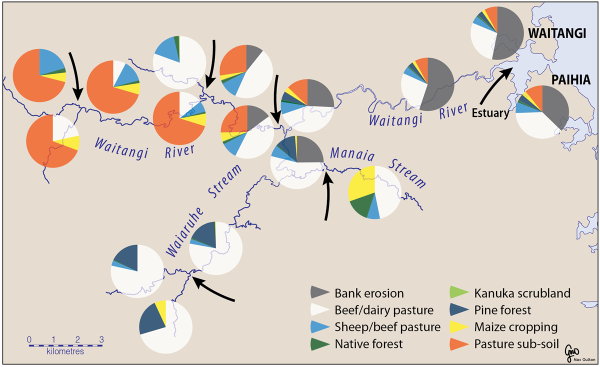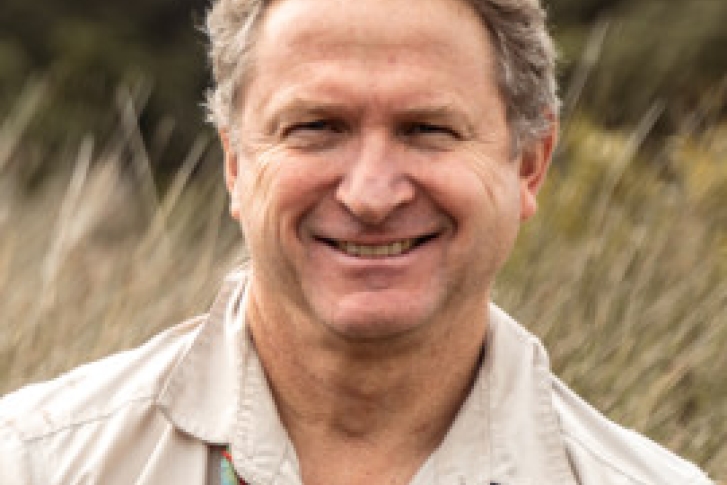Fine sediment is New Zealand’s most widespread water contaminant, degrading ecosystems, infilling dams and reservoirs and impairing recreational, cultural and aesthetic values in our rivers, estuaries and coastal seas.
Soil erosion also reduces productivity on land, with significant economic cost. But to control fine sediment in complex catchments we first need to understand where it is coming from so that mitigations can focus on key sources/land uses.
To help here NIWA has pioneered the use of Compound Specific Stable Isotope (CSSI) sediment tracers to identify the origin of sediment in aquatic ecosystems by land use. Sediment CSSI tracers utilise carbon-13 (13C) stable isotopic signatures of organic fatty acid biomarkers that are incorporated in soils from plant communities that are characteristic of particular land uses. The proportional contributions of different land uses to sediment at points in the aquatic system are calculated using mixing models, based on the known or measured CSSI signatures produced by different land uses.
Over the last decade, the CSSI sediment-source tracing method has been applied to identify contemporary and historical sources of fine sediment accumulating in rivers, freshwater wetlands, estuaries and coastal habitats in New Zealand, and internationally in collaboration with the International Atomic Energy Agency (IAEA).
NIWA’s “Managing Mud” programme is refining the CSSI technique and linking it with other sediment synoptic tools. Refinements include:
- evaluating how long it takes for the 13C isotopic signatures of fatty-acid biotracers to reach a new “steady state” under changing land use, since the early-1990s, from pine forest to dairy pasture near Taupo
- applying new-generation mixing models, incorporating information about source-signature variability, to refine uncertainties in the estimation of source contributions.
Linkage to other sediment synoptics include:
- combining fallout radionuclide (FRN) and CSSI sediment source fingerprinting techniques to improve understanding of the key sources of fine sediment by processes such as stream bank erosion in the Hoteo Catchment (Auckland)
- combining CSSI analysis of suspended sediment with using repeat mobile laser scanner ‘Snoopy’ surveys of flood-induced bank erosion in reaches of the Oreti River to quantify the contribution of bank erosion to measured fine-sediment loads
- extension of the CSSI method to dated sediment cores (e.g., from lakes or estuaries) is providing detailed information for reconstructions of environmental change and determining the persistence of land use sources over annual to centennial time scales
- CSSI methods will be used to validate a computational catchment-to-estuary fine-sediment model, which is a major tool being developed in the Managing Mud programme.
Contact NIWA’s National Centre for Freshwater and Estuaries for more information on the Managing Mud Programme or CSSI sediment-source tracing.
Further reading
1. Gibbs, M.M. (2008) Identifying source soils in contemporary estuarine sediments: A new compound-specific isotope method. Estuaries and Coasts, 31: 344–359.
2. Swales, A.; Gibbs, M.; Hewitt, J.; Hailes, S.; Griffiths, R.; Olsen, G.; Ovenden, R.; Wadhwa, S. (2012). Sediment sources and accumulation rates in the Bay of Islands and implications for macro-benthic fauna, mangrove and saltmarsh habitats. NIWA Client Report HAM2012–048 prepared for Northland Regional Council, 132 pp.
3. Swales, A.; Gibbs, M.; Pritchard, M.; Budd, R.; Olsen, G.; Ovenden, R.; Costley, K.; Hermanspahn, N.; Griffiths, R. (2013). Whangarei Harbour sedimentation. Sediment accumulation rates and present-day sediment sources. NIWA Client Report HAM2013–143 prepared for Northland Regional Council, 104 pp.
4. Gibbs, M., Swales, A., Olsen, G. (2014) Suess effect on biomarkers used to determine sediment provenance from land-use changes. In Heng, L.K., Sakadevan, K., Dercon, G., Nguyen, M.L. (eds), Proceedings — Managing Soils for Food Security and Climate Change Adaptation and Mitigation. Food and Agriculture Organisation of United Nations, Rome, 2014: 371-375.
5. Gibbs, M., Olsen, G., Stewart, M. (2014) New River Estuary sediment sources tracking pilot study. Client report ENS13203 to Southland Regional Council. 39 pp.
6. Gibbs, M., Olsen, G., Stewart, M. (2014) Jacobs River Estuary sediment sources assessment. Client report DNZ13201 to Dairy NZ. 33 pp
7. Swales, A., Gibbs, M., Olsen, G., Ovenden, R. (2015). Historical changes in sources of catchment sediment accumulating in Whangarei Harbour. NIWA Client Report HAM2015-037 prepared for Northland Regional Council, 39 pp.
8. Gibbs, M. (2017). Soil erosion sources and effects. Presentation to Beef & Lamb New Zealand Environment Conference, Wellington, 14-15 February, 2017. PowerPoint available






